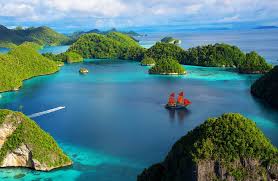Located in Indonesia’s West Papua province, Raja Ampat, the ‘Four Kings’, is an archipelago comprising as many as 1,600 small islands, cays, and shoals.
In recent years, the abundance of ocean life and healthy reefs here has led to much of the area being protected and watched over by Indonesian and international conservation organizations.
Raja Ampat is considered by many experts to be the global epicenter of tropical marine biodiversity. Once only accessible by live-aboard ship, a number of land-based resorts have sprung up, some quite recently.
There are also more modest homestays for budget-minded travelers. The resorts now offer speedboats to take guests from Sorong to the land-based facilities.
Islands like Kri, Birie and Pef all hold some very nice land-based resorts that are quite close to some famous diving and snorkeling sites in the region.
The Cape Kri dive site is just around the corner from two Kri resort facilities founded by Raja Ampat diving pioneer Max Ammer. Cape Kri is a famous current-fed site that consistently produces schools of batfish, barracudas, bigeye jacks, large parrotfish, and many other reef fish in good numbers.
Down deep are thick schools of bright yellow-striped sweetlips; along a sloping wall are rich corals and the occasional grazing sea turtle. It is a diver’s dream when the currents make the fish come to life. The resort even reports a resident dugong! These sea cows are usually shy and an encounter is considered rare.
The ‘kings’ of Raja Ampat are the four main islands of Misool, Salawati, Batanta, and Waigeo. The name ‘Raja Ampat’ comes from local mythology that tells about a woman who finds seven eggs. Four of the seven eggs hatch and become kings that occupy four of Raja Ampat’s biggest islands.
The other three become a ghost, a stone, and a woman. History shows that Raja Ampat was once a part of the Sultanate of Tidore, an influential kingdom from Maluku. Westerners started to venture into these waters, too, seeking spices and exploration. In the late 1600s, the English explorer William Dampier gave his name to the Dampier Strait, which separates Batanta island from Waigeo island.
After some warm-up dives in these straits, it was our goal to move on by diving selected islands and outcrops of partially submerged rocks as we headed north to Waigeo Sebelah Barat Marine Park. We would eventually anchor near the famed karst of Wayag with its rock island overlook then return via the Penemu overlook and Batanta.
At Pulau Wofoh, summer diving can bring a very special seasonal phenomenon. Along with the island’s undersea wall and off the dive site known as Edi’s the Black Forest, millions upon millions of tiny baitfish gather. Immense schools of juvenile sardines, fusiliers, and silversides cover every inch of the reef from the surface to the depths. These tiny fish provide a feast for a number of predators.
Groupers sit on corals and grab a quick meal from their perches. Schools of jacks roam, slashing into the schools for easy prey. Overfed wobbegong sharks lie in caves and on rocky shelves, completely obscured by the mass of fish. Divers have to fan the tiny fish away just to see these resting sharks. In mid-water, the sardine shoals – highlighted by the sun as they move – create a light show of sorts, forming amazing patterns. This is also a nice dive without the seasonal sideshow, but the addition of this fishy mass creates a dive never to be forgotten.
Divers across the equator on the way to Wayag. A series of rocky outcrops, appropriately called The Equator Islands, offer dives that include The Maze.
The divers literally swim across the equator, exploring under pinnacles and swim-throughs filled with surgeonfish and visited by large bump head parrotfish. Other sites like One Tree Rock, which can have raging currents at times or be as calm as a pond at others, hold beautiful masses of yellow polyped tube corals. Open when the current passes them, these species of corals paint the reef in brilliant color. The site also has a huge school of bigeye jacks that divers can watch for a very long time.
The Waigeo Sebelah Barat Marine Park holds lush, jungle-covered islands like Wayag and many other limestone gems that have become the signature image of the entire Raja Ampat region. Sandy beaches with powder-white sand and no ocean debris, shallow coves with healthy coral, and some deeper outside dive sites make this the kind of place that dive ships like to anchor at for a couple of days.
The guests can soak in the amazing beauty and revel in the fact that few people in the world have seen this amazing and unpopulated park area.
The islands are undeveloped and the hike to the top to get to the famous Wayag Staircase overlook is through jagged limestone forest. It is not for the faint-hearted, but the view from the top is well worth the effort. Another scenic site for divers and snorkellers is a place called The Passage. Here the famed biologist Alfred Russel Wallace thought he had found a huge inland lake. Instead, he navigated the ocean channel separating west Waigeo from Gam. The constant currents feed a series of bays, which have shallow coral fans in reds and yellows that sometimes grow right up to the surface. This stretch runs for 2 kilometers and eventually opens into Kabui Bay. Studded with small rock islands, you’ll want to whip out your camera to record the natural topside beauty.



